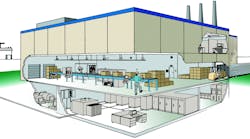Part one of “The Electrical Marketplace” in Electrical Wholesaling's May issue (page 30), covered the largest channels for the sale of electrical products — full-line electrical distributors, hybrid distributors and product specialists. Although most electrical products are sold through these channels, many other sources of supply exist for electrical products.
DISTRIBUTION/SERVICE COMPANIES
The distribution/service companies have a heavy emphasis on design, installation or repair. Although they sell electrical supplies, product sales may not be their primary function. These companies focus on providing a complete service solution to their customers. Here's how the sale of electrical products fit into the package of services that other distribution/services companies offer:
Black Box Corp. This Lawrence, Pa.-based distributor and installer of voice/data equipment is a cross between a distributor and an installer. Its $499.8 million in 2000 sales, catalog with 40,000 computer networking products, and the 40-plus voice/data installers it acquired in the last three years make it a force to reckon with in the voice/data business.
The company, which private labels most of its products, has its roots as a catalog-based direct marketer of networking products, but in recent years has expanded its on-site technical support services. In 2000, this capability accounted for 30 percent of revenues. Black Box considers 2,000 of its 3,500 employees to be technical experts. These employees are either on-site installers or provide fee-based technical support over the telephone. Despite the importance of its on-site technical services, the company's 1,344-page, five-pound catalog still drives the majority of sales.
Black Box's innovative blend of service and distribution capabilities exemplifies just how different the business models of potential competitors may be from that of traditional electrical distributors.
High-tech specialists. The technological shockwaves rocking computer hardware manufacturers, where yesterday's breakthrough product is tomorrow's dinosaur, are felt in the close-knit high-tech market, too. Take the programmable logic controller (PLC), the product most responsible for bringing the power of computers to individual manufacturing processes on the factory floor. In little more than a decade, the PLC has gone from the leading edge of technology to a stepchild overshadowed by the brainpower of the custom application software that tell these devices what to do.
As this market has evolved, so have the purchasing habits of customers, who, to the frustration of distributors, are shopping their quotations for complex packages of products, services and training much more than ever. Years ago, this market was known as a haven for 30-percent-plus gross margins, but in recent years, margins on some projects have hit the levels common in more traditional product markets.
The constant technological innovations in industrial controls shape the product specialties of these companies; in the past few years, some have added expertise in bar coding, as well as motion and positioning products. Down the road, these distributors are looking for software programming to play an even greater role in the package of services they offer customers.
A hot new area in the factory automation market is called “datamation,” which is the fiber-optic wiring systems that link production floor machinery to a corporation's MIS and accounting departments (local or worldwide) so that the company can track production runs in real-time. Many PLCs have ports for Ethernet networking.
Product focus: Control products such as PLCs, sensors, variable-speed drives, machine vision systems, bar-coding equipment and related automation products.
Primary customers: Industrials involved in virtually any manufacturing process and original-equipment manufacturers (OEMs), particularly machine-tool builders.
Number of locations: 300 to 350 companies in the United States.
National association: Over 150 of these companies belong to the Association for High Technology Distribution (AHTD), Philadelphia, Pa., (215) 564-3484.
Association Web site: www.ahtd.org
Energy-services companies (ESCOs): ESCOs offer the most sophisticated package of design, technical assistance, audit and, in some cases, installation services in the entire energy market. Relatively few of them function as distributors in the same sense as the other product specialists mentioned here because their primary interest tends to be in design and installation, not in supply. If ESCOs use subcontractors for installations, they often leave the purchasing up to the discretion of these companies. As electrical distributors who have ESCOs in their markets will tell you, however, the ESCOs have a lot to say about what products are used in the installation of systems.
ESCOs started out in markets with big utility-rebate programs because they helped customers get the most out of them. When ESCOs engage in what is called “performance contracting,” they help a customer purchase the products, and the customer then pays them back based on the electrical energy-use savings it gets from these more efficient products.
Public utilities like what they see in the ESCO business, and over the past few years, many utilities have purchased ESCOs to handle the design and installation of energy-efficient electrical systems, potentially forming a new channel to the market competing with the more traditional distributor-contractor relationship. In light of the current energy crunch, this is a trend worth watching.
The electrical distributors with the best grip on the energy market see ESCOs as customers, not competitors, because they provide them with a reliable, full package of energy-efficient electrical products for their design and installation projects. As this channel evolves, though, electrical distributors may see more ESCOs buying direct from manufacturers, particularly with those companies owned by utilities. Utilities often buy direct because they purchase electrical products in huge quantities, and it's possible that they would continue this practice with the products that their ESCOs install.
Product focus: Relatively few ESCOs are interested in stocking equipment, but the ones that do carry inventory for their installations stock the full range of energy-efficient products: lighting fixtures, lamps, reflectors, variable-speed drives and other types of energy-efficient products.
Primary customers: Retail, commercial, industrial, institutional and government facilities.
Number of locations: 100 to 200 companies.
National association: National Association of Energy Service Companies (NAESCO), Washington, D.C., (202) 822-0950.
Association Web site: www.naesco.org
Lighting maintenance companies. The companies that install and maintain lighting systems are an interesting mix of contractors with a sideline in lighting maintenance; maintenance specialists that compete with contractors; and, on occasion, sources of supply for lighting products that compete with electrical distributors. One firm, Osram Sylvania Lighting Services, Danvers, Mass., is actually a wholly-owned subsidiary of lamp manufacturer Osram Sylvania.
The companies focus on relamping large commercial projects and other large facilities, outdoor lighting and the lighting of parking lots and signs. Along with the installation and maintenance of lighting systems, these companies usually provide facility audits for customers so that they can project potential savings by relamping.
National association: International Association of Lighting Management Companies (NALMCO), Des Moines, Iowa, (515) 243-2360.
Association Web site: www.nalmco.org
Datacom specialists. No two companies are exactly alike in the datacom arena. The players include large distributors that have been in the market for years like Anixter Inc., Skokie, Ill., and Graybar Electric Co., St. Louis; large regional players such as Communications Supply Corp., Chicago, and Washington Cable Supply Inc., Latham, Md.; wire specialists that are part manufacturer; distributors that build small quantities of cable/connector assemblies; regional companies that are subsidiaries or separate business units of full-line electrical distributors; and small companies that go national with toll-free telephone numbers and next-day delivery.
Product focus: Wire and cable, connectors and other networking equipment for computer, telephone and video installations.
Primary customers: Any building with computer, telephone or video systems. Largest customers include computer-intensive service companies, hospitals and industrials.
National association: No national distributor association, but datacom distributors are often members of BICSI, Tampa, Fla., the largest trade association in the voice/data market.
Motor specialists. Motor distributors are enjoying a windfall as federal minimum-efficiency standards spark demand for new motors, much as lamp laws did for lighting products distributors over the past decade. That's welcome news for motor distributors who are still moving toward motor sales from their roots as repair shops. As it got more expensive to repair motors, customers bought new ones instead; today anything smaller than 15 hp is considered a throwaway. Some motor distributors are selling more than just motors, offering energy-saving variable-speed drives and other motor controls.
Product focus: Motors, starters, drives and related industrial controls.
Primary customers: Companies of all sizes in the industrial and commercial market.
Number of locations: 2,500 members in the motor industry's largest trade association.
National association: Electrical Apparatus Service Association (EASA), St. Louis, Mo., (314) 993-2220.
Association Web site: www.easa.org
OTHER CHANNELS
Two years ago, many industry observers thought Web-based companies that offer customers 24-hour access and overnight delivery of a basketful of products would be the most important new channel for electrical supplies to ever challenge the electrical wholesaling industry. That may one day still be the case, but electrical distributors have survived the first assault by Web-based competitors because customers still value their core services — local stock and product expertise.
Along with Web-based competition, other channels for the sale of electrical products do exist. One alternate channel that developed during the 1990s are the alliances between distributors from different trades to service the maintenance, repair and operations (MRO) product needs of industrial customers with a single-source solution.
One must also consider another channel that has been around for much longer than distributor alliances or Web-based competition: direct sales from manufacturers. It's a tough channel to get a fix on because manufacturers don't like to discuss it much. Many manufacturers have national accounts or sell some of their output to other manufacturers for inclusion in the product they make. Direct sales seem to occur most often on large automation, roadway or municipal lighting projects. Although the manufacturers sell these jobs direct, they sometimes place the paperwork through distributors.
An offshoot of direct sales is the situation in the lighting market, where some manufacturers' independent agents take on some of the order-processing and occasionally the stocking responsibilities of the distributor and deal directly with end users. One variation of this arrangement is the “buy/sell” rep, where a rep takes title to (buys) goods from a manufacturer and sells them either to a distributor or an end user.
Future alternate channels. What other channels for electrical supplies may develop in the future? The success of Black Box's business model in the voice/data market makes one wonder if a similar business model could work in the mainstream electrical distribution arena. Although installing electrical systems would put an electrical distributor in direct competition with contractor customers, the idea may not be too far out. Last year, Tyco International Ltd., Hamilton, Bermuda, acquired Fisk Electric, Houston, one of the largest electrical contractors in the United States, so that it could venture into two products areas in which it has manufacturing capabilities — security and voice/data systems.
A potential channel may rise from the ashes of the fallen dot-coms, as entrepreneurs learn from the errors of the first wave, and build on what worked. Some industry observers speculate that electrical distributors may form partnerships with dot-coms where they would service the orders for electrical products on a national or regional basis that are generated by the online storefronts that dot-coms would build.








